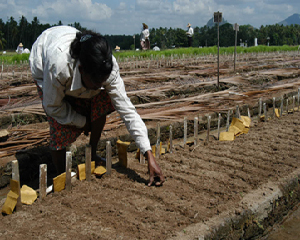
- Address : Bathalagoda, Ibbagamuwa, Sri Lanka
- E- Mail : rrdi@doa.gov.lk
- Telephone : +94 372 258561
- Fax : +94 372 259881
Rice-the staple food-Crop Establishment
Dry-bed Method




Nursery
Nursery location
- Developed in a place other than the prospective rice field.
- should be about 1/10 of area to be transplanted.
- should not be a shady place.
- adequate irrigation facilities should be available.
Construction of the seed bed
- Seed beds of convenient dimensions are prepared by raising the soil to a height of about 5-10 cm.
- A thin layer of half burnt paddy husk could be distributed on the nursery bed mainly to facilitate uprooting.
Nursery maintanance
- Nursery should be maintained
- without any moisture stress.
- A basal fertilizer mixture could be applied and incorporated between rows if the soil nutrient supply is low.
- These nurseries could be raised even during heavy rains which is not possible with wet-bed.
Seed Paddy
Requirement
- About 150 kg/ha.
- Higher than the requirement for wet-bed (as the germination could be lower).
Seed preparation
- Dry or just sprouted seeds are used.
Nursery establishment
- Seeds are sown in rows
- Each row would be about 10cm apart from each other.
- Seeds could also be sown randomly.
- weed control is difficult.
- Therefore, this method is discouraged.
- Seedlings could be uprooted at 15 – 21 days after sowing.
- seedlings are short and strong, has longer root system.
- root system may get damaged during uprooting.
- upland nurseries may get infected with blast and prone to pests (rodents).
Nursery
Nursery location
- Developed in a place other than the prospective rice field.
- should be about 1/10 of area to be transplanted.
- should not be a shady place.
- adequate irrigation facilities should be available.
Construction of the seed bed
- Seed beds of convenient dimensions are prepared by raising the soil to a height of about 5-10 cm.
- A thin layer of half burnt paddy husk could be distributed on the nursery bed mainly to facilitate uprooting.
Nursery maintanance
- Nursery should be maintained
- without any moisture stress.
- A basal fertilizer mixture could be applied and incorporated between rows if the soil nutrient supply is low.
- These nurseries could be raised even during heavy rains which is not possible with wet-bed.
Seed Paddy
Requirement
- About 150 kg/ha.
- Higher than the requirement for wet-bed (as the germination could be lower).
Seed preparation
- Dry or just sprouted seeds are used.
Nursery establishment
- Seeds are sown in rows
- Each row would be about 10cm apart from each other.
- Seeds could also be sown randomly.
- weed control is difficult.
- Therefore, this method is discouraged.
- Seedlings could be uprooted at 15 – 21 days after sowing.
- seedlings are short and strong, has longer root system.
- root system may get damaged during uprooting.
- upland nurseries may get infected with blast and prone to pests (rodents).

This method is used when multiple varieties are grown, each in small quantities. Therefore, mostly popular with researchers.
This method is used when multiple varieties are grown, each in small quantities. Therefore, mostly popular with researchers.
